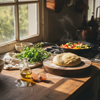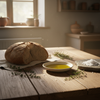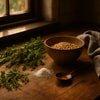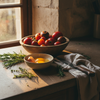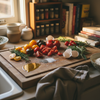Seasonal Baby Purée Recipes to Boost Development
Homemade Baby Purée Magic: Nourishing Little Taste Buds with Seasonal Goodness
There's something magical about that first spoonful—the wide-eyed wonder as your baby discovers the world of flavors beyond milk. As parents, we dream of giving our little ones the absolute best start in life, especially when it comes to nutrition. But let's be honest: between deciphering ingredient labels and juggling busy schedules, the baby food aisle can feel like a minefield of uncertainty. For tips on kitchen efficiency, check out our best cooking utensils.
That's where homemade baby purées come in—not just as meals, but as tiny culinary adventures that build healthy relationships with food from day one. With nothing but fresh ingredients, your trusty kitchen tools, and a dash of creativity, you're about to become your baby's favorite chef. Learn how to get started with basic techniques like how to sauté onions which can add flavor to older baby recipes.
At DI ORO, we believe the tools that touch your family's food matter, which is why we've created this seasonal guide to baby purées that nourish developing bodies and delight curious palates. Let's transform ordinary produce into extraordinary first bites—no culinary degree required! For complementary recipe inspiration, try our delicious steak sandwich recipe.
Why Homemade Baby Purée Recipes Win Every Time

Before we dive into the delicious stuff, let's talk about why making your own baby food is worth the (minimal) effort. Store-bought options certainly have their place—we've all been saved by those convenient pouches during travel emergencies—but homemade baby purées offer benefits that simply can't be packaged:
- Complete ingredient control: You know exactly what's going into your baby's developing system—no preservatives, hidden sugars, or mysterious "natural flavors."
- Superior nutrition: Fresh, seasonal produce contains higher levels of vitamins and minerals than their long-shelf-life counterparts. For ideas on thickening your purées, see how to thicken beef stew.
- Budget-friendly feeding: Homemade baby food costs a fraction of pre-packaged options, making it one of the smartest cheap dinner ideas for 2 (you and baby!).
- Flavor exploration: Introducing diverse tastes early helps develop adventurous eaters later (goodbye, picky toddler phase!). Explore more flavor inspiration with our Chai Tea Latte by Alisa's Garden Blog.
- Reduced food waste: That slightly soft avocado or extra sweet potato from dinner becomes tomorrow's baby meal. For natural pest control in your garden, try our homemade weed killer recipe.
The American Academy of Pediatrics and pediatric nutrition experts, including those at Blueberry Pediatrics, consistently recommend introducing a wide variety of flavors and textures during the first year—something homemade purées make infinitely easier.
Essential Kitchen Tools for Baby Food Success
Before your kitchen transforms into a baby food production line, let's talk equipment. While specialized baby food makers certainly exist (and can be wonderful investments for some families), most home chefs already have everything needed to create perfect purées:
The Must-Haves
- Quality blender or food processor: Your most important tool for creating silky-smooth stage 1 baby food through chunkier stage 3 offerings. For measuring liquids precisely, consider a glass measuring cup.
- Steamer basket: Gentle steaming preserves nutrients better than boiling.
- Ice cube trays or baby food storage containers: Perfect for freezing portion-sized servings.
- Silicone spatula: For scraping every last nutritious bit from your blender. Our award-winning DI ORO Seamless Series spatulas are perfect here—they're heat-resistant to 600°F and made with forever-chemical-free, pro-grade silicone that's safe for your baby's food.
Nice-to-Haves
- Baby food maker: All-in-one steam and blend machines can streamline the process.
- Mesh food feeder: Perfect for introducing texture while minimizing choking hazards.
- Silicone feeding spoons: Gentle on developing gums and teeth.
- Food mill: Creates perfect textures for transitioning from smooth to slightly chunky purées.
Remember, the best tools are the ones you'll actually use. Start simple and invest in specialized equipment only if you find yourself making baby food regularly. For a refreshing drink to enjoy while cooking, try our coffee accessories.
Understanding Baby Food Stages: A Purée Progression
Baby purée recipes follow a developmental progression that mirrors your little one's growing abilities. Understanding these stages helps you create age-appropriate meals:
Stage 1 Baby Food (4-6 months)
When your pediatrician gives the green light to start solids (typically around 4-6 months), stage 1 baby food is your starting point. These purées are:
- Single-ingredient (important for identifying potential allergies)
- Thin, smooth consistency (similar to yogurt for babies)
- Free from added seasonings, even mild ones like Mrs. Dash seasoning
- Often started with iron-rich foods or gentle options like rice cereal for babies
Perfect first foods include simple fruit and vegetable purées like apple, sweet potato, pear, or avocado. Many parents begin with iron-fortified single-grain cereals mixed with breast milk or formula.
Stage 2 Baby Food (6-8 months)
As your baby grows more accustomed to eating pureed food, you can progress to:
- Combinations of two or more ingredients
- Slightly thicker textures
- Introduction of protein sources like pureed chicken or legumes
- Gentle herbs and spices (think cinnamon, mild curry, or basil)
This stage is where culinary creativity begins! Try combinations like apple-cinnamon, sweet potato-banana, or pea-mint.
Stage 3 Baby Food (9-12 months)
As your baby approaches the one-year mark, they're ready for:
- Chunkier textures with soft, mashed pieces
- Complex combinations of multiple ingredients
- More adventurous flavors and seasonings
- Finger foods alongside purées as pincer grasp develops
This transition period bridges the gap between baby food and table food, preparing your little one for family meals. For ideas on finger foods and utensils, see our kitchen utensils guide.
Seasonal Approach: Why Timing Matters for Baby Purée Recipes

While grocery stores offer year-round access to most produce, there's something special about creating baby food that follows nature's calendar. Seasonal fruits and vegetables offer:
- Peak nutrition: Produce harvested in season contains optimal vitamin and mineral content.
- Enhanced flavor: In-season fruits and vegetables simply taste better, helping develop your baby's palate.
- Lower cost: Seasonal produce is typically more affordable, making your baby purée recipes budget-friendly.
- Environmental benefits: Reduced transportation and storage requirements mean a smaller carbon footprint.
Plus, following seasonal rhythms connects your baby to the natural world in a fundamental way—a relationship with food that can last a lifetime. For sweet treats that complement your baby's meals, try our gift card or gifts.
Spring Baby Purée Recipes: Fresh Beginnings
Spring brings tender vegetables and the first fruits of the year, perfect for delicate baby palates just starting their food journey:
Sweet Pea & Mint Purée
Fresh spring peas offer plant-based protein and subtle sweetness that babies love. The addition of mint makes this a sophisticated first food that supports digestion.
Ingredients:
- 2 cups fresh or frozen peas
- 2-3 fresh mint leaves (for babies 8+ months)
- Water, breast milk, or formula to thin as needed
Instructions:
- Steam peas until tender (about 3-4 minutes).
- Transfer to blender with mint leaves if using.
- Purée until smooth, adding liquid as needed.
- For stage 1 baby food, strain through a fine mesh sieve to remove any remaining skins.
This vibrant green purée freezes beautifully in ice cube trays for up to 3 months—perfect for preserving spring's bounty.
Strawberry-Banana Dream
As spring strawberries appear, this no-cook purée makes an excellent second or third fruit introduction for babies who've already tried banana.
Ingredients:
- 1 cup organic strawberries, hulled
- 1 ripe banana
- 1 tablespoon baby yogurt (optional, for babies 6+ months who've been introduced to dairy)
Instructions:
- Steam strawberries for 2-3 minutes to soften and reduce potential allergenicity.
- Blend steamed strawberries with fresh banana until completely smooth.
- Stir in yogurt if using.
The natural sweetness makes this a baby favorite, while the combination provides vitamins C, B6, and potassium for developing bodies.
Summer Baby Purée Recipes: Vibrant Nutrition
Summer's bounty offers a rainbow of options for your baby's developing palate. These sun-ripened fruits and vegetables pack a nutritional punch that's perfect for growing bodies. Let's transform summer's abundance into baby-friendly culinary creations that will have your little one opening wide for more! For more information on benefits of homemade baby food, visit Benefits of Homemade Baby Food.
Peachy Perfection Purée
Nothing says summer quite like a perfectly ripe peach, and this simple purée captures that sunshine sweetness in baby-friendly form. Rich in vitamins A and C, peaches support healthy vision and immune function.
Ingredients:
- 3 ripe organic peaches
- 1/4 teaspoon vanilla extract (optional for babies 8+ months)
- Breast milk, formula, or water to thin as needed
Instructions:
- Bring a pot of water to boil. Score an X at the bottom of each peach.
- Blanch peaches for 45 seconds, then transfer to ice water.
- Peel away skins (they should slip off easily), remove pits, and dice flesh.
- Steam peach pieces for 3-4 minutes until tender.
- Blend with liquid of choice until you reach your desired consistency.
For a stage 2 variation, try combining with banana or avocado for a creamier texture that introduces healthy fats alongside those peachy vitamins!
Garden Zucchini & Basil Blend
When zucchini takes over summer gardens, transform this mild vegetable into a baby food masterpiece. The addition of fresh basil introduces your little one to aromatic herbs that expand their flavor horizons.
Ingredients:
- 2 medium organic zucchini
- 3-4 fresh basil leaves (for babies 7+ months)
- 1 tablespoon olive oil (optional for babies 6+ months)
Instructions:
- Wash, trim, and chop zucchini into 1-inch pieces (no need to peel if organic).
- Steam until very tender, about 5-7 minutes.
- Transfer to your blender along with basil leaves.
- Purée until smooth, adding a splash of water if needed.
- For babies over 6 months, stir in a drizzle of olive oil for healthy fats.
Pro tip: Use your DI ORO silicone spatula to scrape every last bit of nutrition from your blender—those forever-chemical-free, heat-resistant spatulas are perfect for baby food prep where safety matters most! For more on prepping herbs and dips, see our Knorr vegetable dip recipe.
Fall Baby Purée Recipes: Comfort in a Spoon

As temperatures cool, fall brings hearty vegetables and fruits that translate beautifully into nourishing baby purées. These autumn-inspired recipes provide essential nutrients to support your growing baby through changing seasons.
Maple Butternut Bliss
Butternut squash is a baby food superstar—naturally sweet, packed with vitamins, and blends to silky perfection. This recipe takes it up a notch with a hint of real maple for sophisticated little taste buds.
Ingredients:
- 1 small butternut squash
- 1/4 teaspoon pure maple syrup (for babies 8+ months)
- Pinch of cinnamon (optional for babies 7+ months)
Instructions:
- Preheat oven to 375°F. Cut squash in half and scoop out seeds.
- Place cut-side down on a parchment-lined baking sheet.
- Roast until fork-tender, about 45 minutes.
- Scoop flesh into blender, add maple syrup and cinnamon if using.
- Blend until smooth, adding water, breast milk, or formula to reach desired consistency.
This purée freezes beautifully and can be combined with apple for a stage 2 variation that's pure fall in a spoonful!
Pear & Ginger Digestive Aid
Fall pears make a perfect base for baby's developing digestive system, while a hint of ginger adds tummy-soothing properties for babies prone to gas or mild digestive discomfort.
Ingredients:
- 3 ripe organic pears
- 1/8 teaspoon freshly grated ginger (for babies 8+ months)
- 1 tablespoon baby yogurt (optional for babies introduced to dairy)
Instructions:
- Peel, core, and chop pears into small pieces.
- Steam until completely tender, about 8 minutes.
- Transfer to blender with grated ginger.
- Purée until smooth, then stir in yogurt if using.
The natural sweetness of pears means no added sweeteners needed—just pure fruit goodness that supports healthy digestion and provides soluble fiber for regular little systems.
Winter Baby Purée Recipes: Immune-Boosting Goodness
Winter brings hearty root vegetables and citrus fruits that provide exactly what developing bodies need during cold and flu season. These nutrient-dense purées support immune function while introducing complex flavors.
Sweet Potato & Apple Comfort
This classic combination delivers beta-carotene from sweet potatoes and soluble fiber from apples—a nutritional powerhouse that babies universally love. It's the perfect stage 1 baby food with natural sweetness and smooth texture.
Ingredients:
- 1 medium sweet potato
- 1 apple (Pink Lady or Gala work beautifully)
- 1/4 teaspoon cinnamon (optional for babies 7+ months)
Instructions:
- Peel and dice sweet potato and apple into similar-sized pieces.
- Steam together until both are very tender, about 8-10 minutes.
- Transfer to blender with a splash of cooking water.
- Purée until completely smooth, adding more liquid if needed.
- Stir in cinnamon if using.
This purée is practically comfort in a spoon—perfect for winter days when your baby needs both nutrition and warmth.
Citrus-Kissed Carrot Purée
Bright orange carrots get a vitamin boost from a hint of citrus in this immune-supporting blend. The natural sweetness makes it appealing to babies, while the vitamin C helps their bodies absorb the iron from any pureed food served alongside.
Ingredients:
- 4 large organic carrots
- 1 teaspoon fresh orange zest (for babies 8+ months)
- 1 tablespoon olive oil (optional for babies 6+ months)
Instructions:
- Peel and slice carrots into rounds.
- Steam until completely tender, about 10-12 minutes.
- Transfer to blender with orange zest.
- Purée until smooth, adding water as needed.
- Stir in olive oil if using for added healthy fats.
The subtle citrus note elevates this simple vegetable into something special—introducing complex flavors that develop sophisticated palates from the start.
Storage Solutions: Batching Baby Food Like a Pro
Making baby purées doesn't have to be a daily chore. With smart storage strategies, you can prep once and feed for weeks! Here's how to maximize your baby food making efforts:
Freezer-Friendly Formats
The freezer is your best friend when it comes to preserving homemade baby food. Try these methods:
- Ice cube trays: Each cube equals approximately 1 ounce—perfect for portion control and minimizing waste.
- Silicone muffin cups: Create 2-3 ounce portions for older babies with bigger appetites.
- Freezer-safe glass containers: For larger batches of frequently used purées.
Once frozen solid, transfer purée cubes to labeled freezer bags with the date and contents clearly marked. Most baby purées maintain optimal quality for 1-3 months when properly stored. For more creative recipes to pair with your batch cooking, check out our bundles & sets.
Thawing and Serving Safety
When it's time to serve your frozen creations:
- Thaw overnight in the refrigerator for the safest method.
- For quick thawing, place sealed container in warm (not hot) water.
- Never microwave baby food—it creates dangerous hot spots.
- Stir well before serving to distribute temperature evenly.
- Discard any leftover food that's been in contact with baby's saliva.
Remember: previously frozen purées stay safe in the refrigerator for 48 hours, but once thawed should never be refrozen.
With your trusty DI ORO spatula, you'll ensure not a drop of nutritious purée goes to waste during transfer from blender to storage containers. Our seamless design prevents bacteria buildup—a critical safety feature when preparing food for developing immune systems. For hair and skin care after messy meals, try our extra off offers.
Beyond Basic: Elevating Baby Purées

As your baby grows and their palate develops, you can introduce more complex flavors and textures. Here are some ways to take your homemade baby food to the next level:
Gentle Seasoning Strategies
While salt and sugar are off-limits for babies under one year, there are plenty of baby-safe ways to enhance flavor:
- Aromatic herbs: Mint, basil, thyme, and rosemary add complexity without overwhelming.
- Mild spices: Cinnamon, mild curry powder, and turmeric offer both flavor and health benefits.
- Citrus zest: Adds brightness without acidity (avoid actual juice until after 12 months).
- Vanilla extract: A drop transforms fruit purées (choose pure extract, not imitation).
Instead of reaching for Mrs. Dash seasoning, create your own baby-friendly herb blends with fresh or dried herbs that complement your purée recipes.
Texture Progression
As your baby approaches 9-12 months, gradually introduce more texture:
- Pulse rather than fully blend to leave small, soft pieces.
- Mix smooth purées with well-cooked, mashed beans or lentils.
- Fold finely minced, soft-cooked vegetables into smoother bases.
- Introduce soft finger foods alongside purées to develop self-feeding skills.
This gradual progression helps your baby develop the oral motor skills needed for safely handling a variety of textures—an important developmental milestone.
Seasonal Meal Planning: Creating a Balanced Baby Food Menu
Creating a well-rounded menu for your baby doesn't have to be complicated. By following seasonal produce patterns and incorporating a variety of food groups, you'll provide optimal nutrition while keeping baby food prep manageable. Let's explore how to build a balanced baby food routine that grows with your little one.
Sample Weekly Baby Purée Menu
Here's what a week of seasonal baby purées might look like for a 7-9 month old:
- Monday: Morning - Sweet Potato & Apple Comfort; Afternoon - Avocado Purée
- Tuesday: Morning - Peachy Perfection; Afternoon - Garden Zucchini & Basil Blend
- Wednesday: Morning - Banana with baby yogurt; Afternoon - Pear & Ginger Digestive Aid
- Thursday: Morning - Maple Butternut Bliss; Afternoon - Mashed beans with olive oil
- Friday: Morning - Citrus-Kissed Carrot Purée; Afternoon - Apple & Spinach blend
- Weekend: Mix favorites with new introductions like pureed chicken or fish (for babies 8+ months)
Rotate through seasonal options while maintaining a balance of fruits, vegetables, and eventually proteins. This approach ensures nutritional variety while making the most of what's fresh and affordable at your market.
Incorporating Rice Cereal and Grains
Rice cereal for babies has traditionally been recommended as a first food, though current thinking has evolved. If you choose to include it, here's how to do it thoughtfully:
- Select iron-fortified organic varieties without added sugars
- Mix with breast milk, formula, or purée rather than water for added nutrition and flavor
- Consider other whole grain options like well-cooked oatmeal or quinoa for greater nutritional variety
- Use as a thickening agent for runny purées as your baby advances to thicker textures
Remember that rice cereal isn't mandatory—many babies do wonderfully starting with vegetable and fruit purées that offer more flavor and nutritional diversity. Consult your pediatrician or resources like Blueberry Pediatrics for personalized guidance based on your baby's development. For scientific insights on infant nutrition, see this research article.
Building Healthy Eating Habits From Day One
The baby purée stage is about more than just nutrition—it's laying the foundation for a lifetime of healthy eating habits. By thoughtfully introducing a variety of flavors and textures, you're helping your baby develop an adventurous palate.
The Importance of Repeated Exposure
Research shows that babies may need 10-15 exposures to a new food before accepting it. Don't be discouraged by those scrunched-up faces or turned heads! Keep offering a variety of baby purée recipes with these strategies:
- Pair new flavors with familiar favorites (like sweet potato with a bit of new vegetable)
- Try serving rejected foods at different times of day
- Model enjoyment by tasting (and genuinely appreciating) the foods yourself
- Keep mealtimes positive and pressure-free—forcing rarely works
Your DI ORO silicone spatula makes this repeated exposure easier—you can quickly scrape every bit of that nutritious purée from your blender into storage containers, ensuring you have plenty of portions for multiple introductions without extra prep work.
Transitioning from Purées to Finger Foods
Around 9-12 months, most babies are ready to begin the exciting journey toward self-feeding. This doesn't mean abandoning purées entirely—think of it as a gradual evolution:
- Begin with soft, mashable finger foods alongside thicker purées
- Offer small pieces of ripe banana, well-cooked pasta, or soft avocado
- Create toddler food ideas that bridge the gap—like vegetable fritters or soft bean patties
- Continue offering puréed food at meals while increasing finger food opportunities
This balanced approach respects your baby's developmental timeline while encouraging independence. Some babies dive enthusiastically into self-feeding, while others prefer assisted feeding longer—both approaches are perfectly normal.
Budget-Friendly Baby Food Strategies

Making your own baby purée recipes doesn't have to strain your wallet. With some strategic planning, homemade baby food can be one of the most economical choices for your family.
Affordable Ingredient Selection
Creating nutritious baby food on a budget starts with smart shopping:
- Focus on seasonal produce when it's at peak abundance and lowest price
- Consider frozen fruits and vegetables—they're flash-frozen at peak ripeness and often more affordable
- Buy in bulk when produce is on sale, then prep and freeze
- Incorporate economical protein sources like lentils, beans, and eggs (yolks only until 12 months)
- Use the same ingredients you're preparing for family meals—just set aside portions before adding salt or strong seasonings
This last strategy is particularly brilliant for creating cheap dinner ideas for 2 (or more) that can double as baby food components. For ideas on kitchen tools that make this easier, see our frontpage collection.
Minimizing Food Waste
When you're making small quantities of baby food, preventing waste becomes essential:
- Freeze purées in appropriate portion sizes for your baby's current appetite
- Label everything clearly with contents and date
- Create a "use first" section in your freezer for older purées
- Repurpose unused thawed purées in family recipes—blend into smoothies, soups, or sauces
- Use your DI ORO spatula to capture every last nutritious bit from blending containers
That last point is no joke—our seamless silicone spatulas help you rescue every spoonful of that lovingly prepared baby food from your blender or food processor. When you're dealing with small batches, those extra tablespoons really add up!
When to Seek Professional Guidance
While making baby purée recipes at home is generally straightforward, certain situations warrant professional input:
Consulting Your Pediatrician
Reach out to your child's doctor if you notice:
- Signs of possible food allergies (rash, hives, vomiting, or breathing changes)
- Consistent refusal of multiple foods over extended periods
- Difficulty progressing to thicker textures or finger foods by 12 months
- Poor weight gain or growth concerns
- Frequent gagging or choking beyond the initial adjustment period
Services like Blueberry Pediatrics offer convenient telehealth options for getting quick answers to feeding questions without an office visit. Your pediatrician remains your best resource for personalized guidance based on your baby's unique developmental timeline.
Embracing the Baby Food Journey
As we wrap up our seasonal baby purée guide, remember that this feeding journey is just that—a journey. There will be messy high chairs, rejected spoons, and occasionally, a food baby situation requiring an emergency bath. But there will also be moments of pure joy as your little one discovers the delicious world you're creating for them.
With your trusty DI ORO kitchen tools and these seasonal recipes, you're equipped to provide optimal nutrition while fostering healthy eating habits that will serve your child for life. From those first tentative tastes of sweet potato to more adventurous blends, each spoonful contributes to your baby's development in ways that extend far beyond simple nourishment.
So embrace the rainbow of purées, the occasional food-covered kitchen, and yes, even those scrunched-up faces of disapproval. You're not just feeding a baby—you're nurturing a future food lover with every carefully prepared bite. And that's a gift that truly keeps on giving, from their first purée to their first cooking adventure of their own someday.
Now, grab that spatula and get pureeing—your little gourmet awaits!
For more homemade baby food recipes and inspiration, visit Homemade Baby Food Recipes.
Frequently Asked Questions
What foods to mix for baby puree?
When making baby puree, you can mix mild and easily digestible foods such as sweet potatoes, carrots, peas, apples, and pears. Combining vegetables with fruits like apple and carrot or sweet potato with pear adds natural sweetness and variety. Additionally, pairing proteins like lentils or chicken with vegetables helps introduce balanced flavors and nutrients.
What is good puree for babies?
Good puree for babies is smooth, nutritious, and made from fresh, wholesome ingredients like steamed vegetables, ripe fruits, and well-cooked grains or proteins. It should be free from added salt, sugar, or spices to suit their developing digestive systems. Purees like mashed avocado, banana, or sweet potato are gentle options that offer essential vitamins and minerals.
Is it really cheaper to make your own baby food?
Yes, making your own baby food is often more cost-effective than buying pre-packaged jars. You can buy fresh produce in bulk or when in season, which reduces expenses, and avoid paying for packaging or brand premiums. Homemade purees also allow you to control ingredients and portion sizes, which can help reduce food waste.
What to cook for a 7 month old baby?
For a 7-month-old baby, you can prepare soft, smooth purees from single or combined ingredients like carrots, peas, sweet potatoes, apples, and pears. You can also introduce small amounts of well-cooked lentils or finely shredded chicken for added protein. It’s important to ensure the texture is appropriate for their developmental stage, starting with smooth purees and gradually offering thicker consistencies.
When should babies stop eating purees?
Babies typically start transitioning away from purees around 8 to 10 months old as they develop chewing skills and interest in textured foods. By 12 months, many babies are ready to eat mashed or finely chopped family foods. However, every baby is different, so it’s important to follow your child’s cues and consult with your pediatrician.
When can a baby have yogurt?
Babies can usually start eating plain, full-fat yogurt around 6 months of age, once they have begun solid foods. Yogurt is a good source of calcium and probiotics, but it’s best to avoid flavored or sweetened varieties to prevent added sugars. Always introduce new foods gradually and watch for any signs of allergies or intolerance.
-
Posted in
baby food maker, baby snacks, baby yogurt, pureed, rice cereal for babies
